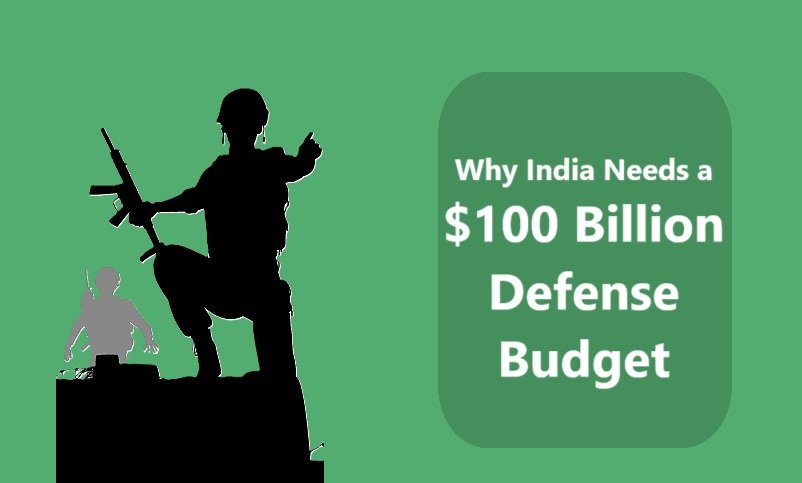
India’s defense budget for 2024-25 stands at approximately $78 billion, making it the third-largest military spender in the world after the United States and China. While this allocation reflects the nation’s commitment to security and modernization, it remains insufficient considering India’s evolving strategic landscape. Given the increasing security threats, modernization requirements, and geopolitical ambitions, India must raise its defense budget to at least $100 billion.
Explore this : India’s Defence Budget 2025-26: Key Allocations, Strategic Implications
A larger budget would ensure enhanced combat readiness, boost domestic defense manufacturing, improve technological advancements, and position India as a dominant military force in the Indo-Pacific region. Below are the key reasons why a $100 billion defense budget is not just desirable, but a necessity.
1. Countering the China-Pakistan Threat: A Two-Front Challenge
India faces complex security challenges from both China and Pakistan. China, with a defense budget exceeding $225 billion, has been rapidly modernizing its military capabilities, including hypersonic missiles, stealth fighter jets, advanced naval warships, and cyber warfare units. The People’s Liberation Army (PLA) has significantly improved its border infrastructure along the Line of Actual Control (LAC), which has led to increased tensions with India, as seen in the 2020 Galwan Valley clash.
On the western front, Pakistan continues to invest in its military capabilities, particularly its nuclear arsenal, drone technology, and asymmetric warfare strategies. Cross-border terrorism remains a persistent threat, with Pakistan-backed militant groups regularly attempting infiltrations into Indian territory.
A $100 billion defense budget would allow India to:
- Strengthen border infrastructure for faster troop mobilization.
- Enhance surveillance and intelligence capabilities using drones and satellite technology.
- Invest in long-range missile systems and modern air defense networks to counter potential aggression.
Without a significant budget increase, India risks falling behind in military preparedness against these two adversaries.
2. Military Modernization and Technology Advancement
A large portion of India’s defense inventory comprises outdated equipment. The Indian Air Force (IAF) still operates several squadrons of aging MiG-21 fighter jets, while the Navy lacks a third aircraft carrier to maintain a strong presence in the Indian Ocean Region (IOR). Meanwhile, the Army requires modern tanks, artillery, and night-fighting capabilities to maintain an advantage in high-altitude warfare.
A $100 billion budget would accelerate modernization efforts by allowing India to:
- Procure 4.5-generation and 5th-generation fighter aircraft like the Rafale and AMCA.
- Expand its naval fleet with additional destroyers, submarines, and aircraft carriers.
- Develop indigenous hypersonic weapons and missile defense systems.
- Upgrade infantry equipment with advanced rifles, communication systems, and combat gear.
India must keep pace with global military advancements, and a higher budget is essential to achieve that.
3. Strengthening Self-Reliance: Boosting Domestic Defense Manufacturing
India has long relied on foreign military imports, but the “Make in India” initiative aims to reverse this trend by promoting indigenous defense production. Increasing the budget to $100 billion would provide the necessary financial push for domestic defense manufacturers, including Hindustan Aeronautics Limited (HAL), Bharat Electronics Limited (BEL), and private sector companies like Tata Advanced Systems and Larsen & Toubro.
A larger budget would:
- Enable faster development and deployment of indigenous fighter jets like the Tejas Mk2 and AMCA.
- Accelerate the production of Arjun tanks and indigenous artillery systems.
- Support research and development (R&D) in advanced military technologies such as artificial intelligence (AI), robotics, and directed-energy weapons.
- Boost India’s defense exports by increasing production capacity for international markets.
Investing in self-reliance not only enhances national security but also reduces dependence on foreign suppliers, ensuring long-term sustainability.
4. Expanding Global Influence and Strategic Partnerships
India aims to establish itself as a leading military power, particularly in the Indo-Pacific region, where China is aggressively expanding its influence. The Indian Navy plays a crucial role in maintaining freedom of navigation in the Indian Ocean, and a $100 billion budget would enable:
- Increased deployment of warships and submarines in strategic areas.
- Expansion of joint military exercises with allies such as the United States, France, and Australia.
- Strengthening of partnerships under Quad (India, US, Japan, Australia) to counter Chinese dominance.
- Enhancing military aid and cooperation with neighboring countries to strengthen regional security.
A well-funded military would reinforce India’s position as a key player in global geopolitics.
5. Addressing Emerging Threats: Cyber Warfare and Space Security
Modern warfare is no longer confined to land, sea, and air. The future battlefield includes cyberspace and outer space, and India must be prepared for these emerging threats.
Cybersecurity
China has one of the most advanced cyber warfare programs in the world, capable of launching large-scale cyberattacks against enemy nations. India, too, has been a target of cyber espionage, with attacks on government institutions, financial sectors, and defense networks.
A higher defense budget would:
- Strengthen India’s cyber defense infrastructure.
- Develop offensive cyber capabilities to counter potential cyber threats.
- Invest in AI-driven cybersecurity solutions.
Space Warfare
Space has become the new frontier for military dominance. China and the United States have already developed anti-satellite (ASAT) weapons. India successfully tested its own ASAT missile in 2019, but further investments are needed to enhance space-based defense capabilities.
An increased budget would enable:
- Deployment of more military satellites for communication, navigation, and surveillance.
- Development of space-based missile defense systems.
- Strengthening of India’s Space Command to counter potential threats in space.
Cyber and space security are integral to national defense in the 21st century, and India cannot afford to fall behind.
6. Boosting Employment and Economic Growth
A higher defense budget would have significant economic benefits, including:
- Job Creation: Expansion of the defense sector would generate millions of jobs in manufacturing, R&D, and engineering.
- Technological Advancements: Increased investment in defense R&D would drive innovation in critical fields such as robotics, aerospace, and AI.
- Industrial Growth: Strengthening domestic defense production would benefit industries such as metallurgy, electronics, and heavy machinery.
By investing more in defense, India would not only strengthen its security but also stimulate economic growth.
Conclusion: A Strategic Imperative
India’s defense challenges are complex and evolving. With China’s rising military dominance, Pakistan’s persistent threats, and emerging cyber-space warfare, a $100 billion defense budget is not just a financial decision—it is a strategic necessity.
A well-funded military would:
✅ Strengthen national security against China and Pakistan.
✅ Accelerate military modernization and technological advancements.
✅ Boost indigenous defense production and reduce reliance on foreign imports.
✅ Expand India’s global influence and strengthen strategic partnerships.
✅ Enhance cybersecurity and space defense capabilities.
✅ Create jobs and stimulate economic growth.
India aspires to be a global superpower, and a $100 billion defense budget is the foundation for achieving that goal. It’s time for India to prioritize national security and ensure that its armed forces remain among the most powerful in the world.




